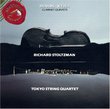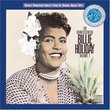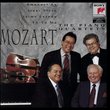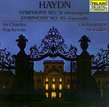| All Artists: Brahms, Perlman, Ashkenazy Title: Violin Sonatas 1-3 Members Wishing: 0 Total Copies: 0 Label: Angel Records Release Date: 10/25/1990 Genre: Classical Styles: Chamber Music, Instruments, Strings Number of Discs: 1 SwapaCD Credits: 1 Other Editions: Great Recordings Of The Century - Brahms: Violin Sonatas nos 1 - 3 / Perlman, Ashkenazy UPC: 077774740326 |
Search - Brahms, Perlman, Ashkenazy :: Violin Sonatas 1-3
 | Brahms, Perlman, Ashkenazy Violin Sonatas 1-3 Genre: Classical
Itzhak Perlman is the greatest living exponent of the Romantic, sentimental style of violin playing. As in his reading of the Brahms concerto, he shows sovereign mastery in these accounts, which are characterized by intens... more » |
Larger Image |
CD DetailsSynopsis
Amazon.com essential recording Itzhak Perlman is the greatest living exponent of the Romantic, sentimental style of violin playing. As in his reading of the Brahms concerto, he shows sovereign mastery in these accounts, which are characterized by intense emotion and heated expression (Perlman's warm vibrato and carefully placed portamentos quickly give him away), but are also gripping in the quiet, meditative pages. The first two sonatas' relationship to songs could easily be guessed from the way Perlman plays them in a single, seamless line, marked by soaring climaxes and tender, haunting pianissimos. The treatment sometimes does seem a bit premeditated, but it is so compelling as to sweep aside any criticism. In this 1983 recording (sonically superior to Perlman's later remake with pianist Daniel Barenboim, for Sony), the violin sounds slightly forward, though not unpleasantly so. Warm, supportive, lyrical playing from Vladmir Ashkenazy rounds out a marvelous offering. --Ted Libbey Similarly Requested CDs
|
CD ReviewsFinest Brahms Michael Poole | Medway, MA United States | 05/21/2002 (5 out of 5 stars) "I've always enjoyed Brahms' chamber works more than his symphonies. Somehow his intent comes off more clearly; the desperation and anger and melancholy of the music is more exposed, as if juggling an entire orchestra in the composition could dull the edges of these emotions. Of course the quality of any piece is tied with the quality of the performers (who invariably stamp then with their own personalities), and here we have a brilliant union: Perlman and Ashkenazy play flawlessly. Perlman's tonality is clear and sonorous, but never treacly; it still maintains the edge that these pieces require. From the sweet lilting melodies of the first sonata to simmering violence of the third, it is a commanding performance. The piano part in these works is equally demanding, and Ashkenazy is more than a match for Perlman's virtuosity.If you're looking for the third sonata specifically, Vengerov and Barenboim turn in a more stirring (but somewhat looser) performance on the Teldec label. I actually prefer that version as it's more intense, more intimate. But if you're looking for a complete collection of these wonderful sonatas, you simply can't go wrong with Perlman and Ashkenazy." Enchanting performance! Curtis Grindahl | San Anselmo, California USA | 05/18/2001 (5 out of 5 stars) "I'm a lover of fine music though I'd never present myself as an expert. I purchased this recording on the basis of the Amazon review and have been unable to get it off the carousel of my CD player. There is magic that happens between these two musicians that I feel honored to experience in my home. I can't imagine anyone performing these sonatas better. The music is hauntingly beautiful to me. It is so good, in fact, that I've searched out other pieces performed by Ashkenazy and Perlman and can also recommend their Decca Legendary performance of Beethoven's Kreutzer and Spring violin sonatas. I recommend both recordings without hesitation. Enjoy!" Perlman and Ashkenazy do it again Jeff Davis Maynor | Baton Rouge, LA United States | 07/23/2001 (5 out of 5 stars) "The combination of these two great artists continually results in some of the finest music making ever. The two seem to almost share a mind while performing so perfectly in tune with each other they come across. I don't think Brahms has ever sounded so beautiful and alive as this recording manages to sound."
|

 Track Listings (10) - Disc #1
Track Listings (10) - Disc #1








